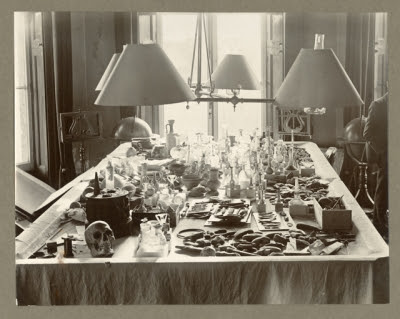Catherine E. Parsons was born in Horseheath, south of Cambridge, in 1870, and became an important local historian, publishing detailed accounts of Horseheath Hall and All Saints' Church in Horseheath, based on extensive research in wills and parish records, particularly from the late fourteenth century onwards.
She excavated sites, researched countless ancient archives, and traced the history of people and places in Horseheath, and collected "bygones, mainly from the cottages of Cambridgeshire" Once she rescued an early Georgian parish constable's staff which was being shaved down for a broom handle. She also collected keys - this is the 1000th key from her collection, with its original carefully written label.
© Pitt-Rivers Museum Oxford
She donated all of her key collection to the Pitt-Rivers Museum in Oxford in 1950, possibly because she had studied closely Pitt-Rivers' book "On the Development and Distribution of Primitive Locks and Keys", when she began to collect in the late 1890s. As her collection included examples from Japan, India, North Africa and Coptic Egypt, tracing their technology chronologically, maybe she felt the collection as a whole would not fit as well in a local Cambridge museum.
General Pitt-Rivers' collection was arranged by type of object, not by geographical source, so that European breast-plates would join coconut-matting armour from Polynesia, and Roman pottery lamps would sit with stage-coach lanterns. Pitt-Rivers introduced the same methodology to his anthropological collections as to his pioneering system of archaeological excavations, giving equal attention to mundane objects as to more eye-catching finds. Today the Pitt-Rivers Museum is one of the world's finest (and most evocative) anthropological museums.
Some of Pitt-Rivers' finds on the billiard table at his Rushmore home.
© Pitt-Rivers Museum Oxford
I first became interested in Catherine Parsons as a friend of Dr. James W. L. Glaisher (see A Cabinet of Collectors 3), and a fellow member of the Cambridge Antiquarian Society.
She was collector and also a recorder of folklore, and presented a paper on witchcraft to the Antiquarian Society in 1915. She says that her interest in this field was begun by scary stories of the "little hairy men" in the Horseheath woods, which the nursery maids told her as a child.
In her account of Horseheath village life, Some Recollections of a Cambridgeshire Parish*, there are only a few personal reminiscences, but she describes a local washerwoman considered a witch, admiring her many voluminous skirts, crossover (shawl) and poke bonnet, and she carefully recorded villagers' superstitions and cures. Their belief in the efficacy of spiders (hung around the neck in a walnut shell or in muslin) survives from well back to the early seventeenth century, when their Lord of the Manor, Sir Giles Alington, noted that "four or six great spiders mingled with English honey and bound to the place" would cure an adder sting. ( Catherine researched his manuscripts in the Bodleian Library for her fascinating account, Horseheath Hall and its Owners*.) She also notes that young men and women returning from the First World War were no longer so convinced by these old superstitions.
The White Horse Inn became the Cambridge and County Folk Museum
© Museum of Cambridge
As well as her publications, her legacy was the Cambridge and County Folk Museum, founded after committed campaigning by Catherine (its first honorary curator) and her friends, along with her collection of Cambridge village bygones, in 1936. Now renamed as the Museum of Cambridge, it celebrates its 80th anniversary later this year.
*Originally published in the Proceedings of the Cambridge Antiquarian Society
See: C. Wingfield, Finding the Key (england.prm.ox.ac.uk)
and: Welcome to Horseheath (www.horseheath.info)



No comments:
Post a Comment